Artistic Practice Teaching Commissions and Collaborations
Julia Waraksa is a Polish artist based in Antwerp, Belgium, working within the disciplines of archival practices, photography, bookmaking and installation in the form of scenography. She studied at the Royal Academy of Arts in The Hague and has a technical background in graphic design. Her artistic research is based on the topics of collective memory, historical trauma, ethics and representation. In 2024–2025 she is partaking in Breedbeeld Photographic Residency and HUP Artistic Residency.
For any inquiries please e-mail info@juliawaraksa.com.
Artist Statement
The tragedies of the twentieth century demonstrated that the scale of ruination runs parallel to the scale of our collective conscience. The ascent of memorial sites, rituals of remembrance, and record-keeping, displays both our active participation in the definition of a collective memory, as well as a shared effort to be absolved of our collective accountability.(Expand)
War, never absent from the course of globalisation and history, has in current times returned to the European mainland. In a region still deeply scarred from the moral ruins of genocides, we are witnessing the resurrection of hubris, of blindness, and of the greed of a mankind which is yet again stumbling over its concept of ethics and of God. Witnessing renewed radicalisation, dehumanisation and othering, we should conclude that our shared and collective memory has begun crumbling at its foundations and it is safe to say those foundations had already been shaking for a while. But in the current face of forgetfulness, in the compliance to time and in the submission to a past as is – a past absolved from consequence – the urgency is now to advance from the current state of perpetuated muteness. Truth conceals itself not in what is spoken, but in the absence of words. What can mankind see without sight?
My practice aims at a closer examination at what lies at the core of collective memory and the processes facilitating catharsis, through an investigation into visual and literary archives. This process narrowly traces the lines of thought set out by Jacques Derrida in his seminal essay Archive Fever. The author bridges the concept of the commencement and the commandment (from the greek arkhē), to the house of magistrates (arkheion), those who alike archives command and act commencement. Our current wars are wars of information and their first casualty is truth. Remembrance has thus never been more of a radical political act than it is in the face of today’s post-truth condition. In Derrida’s sense those who command the archives hold sway and power over our liberty of catharsis and change. They thus dictate, as history has shown since times immemorial, our collective understanding of those processes which must occur for the moral act of remembrance to begin taking place. Through my projects I attempt to form a common voice that resonates to what is both near and ancient, thereby overriding the traditional linearity of narrative and subverting the power of the Arkheion, the edifice. My work situates itself within recreations of places and scenarios in which original definitions were conceived, but where understanding is still taking shape.
Through the insertion of absences and through the careful editing of language I underline the discrepancies which occur between meaning and intent. This takes place on a literary and photographic level, consciously choosing mediums which derive their fluency from verse and the poetical. In the use of physical materials, my preferences tend toward bare and crude forms, existing in their unshaped, stripped state, yet devoid of definition.
This makes for a practice ever-evolving. Free from the confines of definition, my focus is set on uncovering a greater narrative that transcends beyond historicity. This pursuit is accompanied by the writings of Simone Weil, who situated her individual being into suffering, so as to be able to take the form of the greater struggle beyond her.
As of January 2023
Artistic Practice





Archive. 2022 – present. 35mm film photography.
In an attempt to make sense of my century, my photographic eye captures the ecological, human and urban traces of ruin, as their processes of decaying actively inscribe themselves into the geological and social landscape. The archive investigates the appearance and consequence of our current condition and what I label a “hurried pull towards the future” (in reference to the twentieth century revolutions) – a momentum that simultaneously and ostensibly rejects the formation of a past.
The archive follows no clear stream of historicity, but rather presents itself as a study of behavioural repetition across varying socio-political climates that share one thing in common: the pursuit of endless acceleration, at the cost of ecologically balanced cycles of growth and decay. The archive currently spans geographically across Ukraine, Romania, Belgium, Germany, Moldova and Sicily.






On a Destiny, Undefined. 2024, in flux. Reinterpreted archival footage.
An on-going examination and reinterpretation of historical photos of the WWI and WWII periods. The selected photographs have been re-framed, cut and cropped, as to cancel out the original motivation of the photo. What remains are traces of human activity: a single hand in the corner, a fingerprint on the photograph, a shape that appears to form a lifeless body, or a human form with faded contours that alludes towards the surreal.
(Expand)
By focusing on the impaired surroundings and thus the consequence of senseless destruction, the human as catalytic element shifts itself to occupy the background. History is no longer situated – what we are left with instead are glimpses into a rather recent, and possibly near future.
"[…] to dialecticize the visible. That is, to make other images, other montages; to look at them differently; to introduce into them division and movement combined, emotion and thought combined. In short, to rub one’s eyes, to rub the representation with the affect, the ideal with the repressed, the sublimated with the symptomal." (1)
1) G. Didi-Huberman, “To Render Sensible”, What Is a People?, Edition A. Allen, New York 2016, p. 70.





Not to bear Witness, but to bear Presence. 2024. Poster, texts and photography.
icw. Tudor Bratu
"In the desert of history every step forward seems a lurch towards a past that divulges itself as an unbound trace. This trace scatters as it attempts to form a path, while it simultaneously crosses the organ that propels it onwards. The resulting dichotomy becomes indicative of a linearity that is both leading, and disorienting – a dance that elegantly, yet covertly, omits the collision with a collective memory that is often presumed to be final. Remembrance seems hardly possible without this misleading dance, for the act of remembering carries within itself an act of betrayal – both a forgetting, and an absence. There is hardly a history without a submission to this movement, and therefore, hardly a history without an admittance to a perpetuation of betrayal, or to forgetting, or to absence.
The blind admittance to this linearity suggests a missing language – a dialogue that cannot be held until words are formed and spoken, and then, with the greatest hesitation, left unbound. To chisel words into a stone not to form them, but to suggest the movement and the force that makes the cut. To trace a footprint not in order take the same path, but to deepen the imprints left behind. The gaze leads itself to the picture not to bear witness, but to bear presence." (Julia Waraksa, 2024)








A Bear Trap in No Man's Land. 2022. Publication, texts and scenography. Edition of 20.
Monuments, documents, and records of collective trauma exist to stand for and contain that which has happened. But in an attempt to lighten the burden of atrocity and barbarism, these mementos simultaneously distance us from the context that birthed them. Through the act of burying and depositing history in monuments and artefacts and by grouping victims into categories and statistics, we are letting a passive silence do the work an active memory should engage. The moment a violence of the past resurfaces, we detach in disbelief and in repetition.
(Expand)
The publication intertwines two archives that bear witness to the violence of the twentieth century: photographic records (witnesses) and literary reflections (the work of mourning). With facts eschewed to an index in the back, the visual and literary representations affect the reader as they echo the histories that contain them. The project proposes a reflection on trauma and the administration of a regime of tragedy that ensued within as well as characterised the twentieth century.
Within the installation the publication is accompanied by a collection of photographs which display sites of former concentration and transit camps across Eastern Europe. Eighty years later, as testament to the negligence towards our collective memories, these forlorn sites have become fragmented representations of an inexpressible absence. It is through monuments that a language of heroism rewrites senseless death as martyrdom, thereby annulling the necessity of a work of memory.






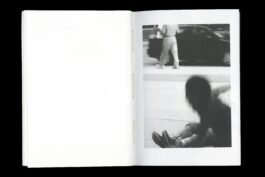

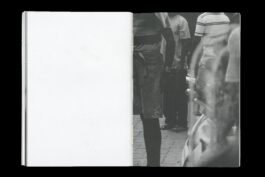

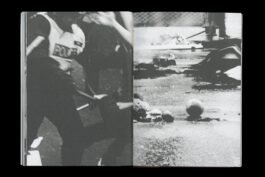

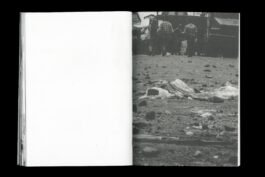


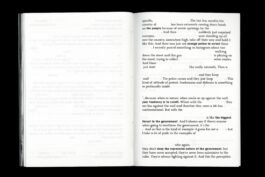

The Poetry of Protest. 2019. Publication, texts and scenography.
Where protests are part of a systematic, nonviolent campaign to achieve a particular objective, involving the use of pressure and persuasion, they go beyond mere protest as a definition and may better be described as cases of civil resistance – or situations of absolute chaos. The Poetry of Protest takes a look at the character of protest, decomposing its underlying destructive nature through a poem in three verses: the chants, the chaos and the aftermath. Selected spreads.
(Expand)
"Action possesses a second virtue within the sphere of incitations. It not only confers reality upon incitations which previously, existed in a semi-phantasmal state: it also causes incitations and feelings to arise in the mind which previously didn't exist at all. That happens every time either the enthusiasm of the moment or the force of circumstances causes the action to go beyond the total sum of energy contained in the incitation which has produced the action. This mechanism –knowledge of which is essential for the conduct of one's own life as for its action upon men in general– is equally capable of producing evil or good." (1)
1) S. Weil, "The Growing of Roots", The Need for Roots, Editions Gallimard, trans. by Arthur Wills, 1952. p.207.
Teaching
















In Loving Memory. 2024. Spacemakers Residency Programme, Galerie Pouloeuff
icw. Tudor Bratu
Month long residency in which artists Madeleine Elisabeth Peccoux, Yawen Fu and Pelle Nijburg delved into the National Dutch Archives to develop a completely new work. Together with Tudor Bratu, we guided them to seek alternate methodologies to expand their pre-established artistic practices. The selected entries in the archive were addressed by the artists from positions of individual consciousness, posing critical questions towards the authenticity of (national) memory. The works were exhibited at the Galerie Pouloeuff in Naarden Vesting, from 24 September to 24 October, 2024.














Reality, Fiction & Other Truths. 2024. Course given during the Art Labs Programme at the AKI University of Art and Design.
Over a period of 2 months and across 6 intensive workshops days, I took the second and third year students from the AKI Fine Arts department through my course "Reality, Fiction & Other Truths". The programme encompassed a wide variety of activities, reading material and lectures to bridge the students' individual art practices with language and literature, and to inspire within them the discovery of language as a medium. During the course, the students learned to investigate, analyse and re-purpose words and their relation to image and perception, allowing them to question, re-contextualise and reappropriate meaning through their own artistic lens. The course finished with an exhibition day, and the works were archived in an exhibition booklet where the project captions were written by the students as poems.
Commissions and Collaborations






























Luuk van Raamsdonk, My Sweet Elora. 2024. Selected spreads.
First self-published edition by Belgian photographer Luuk van Raamsdonk.
“My Sweet Elora is a collection of photographs and moving images of both the past and present Elora. Using them to dissect the complicated nature of family dynamics. While also using it as an ongoing formulation of personal identity and self within the context of family history.
Through this journey, I confront the unresolved questions of love, loss. It is a mirror reflecting the cycles we inherit, the secrets we uncover, and the choices we make to shape our future. Elora becomes a symbol—a place where the past collides with the present, where the personal and universal intersect. This body of work is both a reckoning and a reconciliation. “
Project text by Luuk van Raamsdonk.

























Eva van Hees, The Fragile Archives. 2024. Selected spreads.
Design, guidance and editing for the book by the Dutch photographer Eva van Hees. At the time of working on this project, Eva’s grandmother was already unable to recall many of the faces and names of her life’s archive, and was hence unable to help her through this process. In The Fragile Archives, Eva addresses her grandmother's advanced dementia diagnosis through questions of what it means to live a life without the bulk of one's memory, as well as the purpose of documentation if the context is bound to be lost. Eva takes the attempt to recover the archive by reappropriating her grandmother's memories as her own, leaving only glimpses in reoccurring faces and themes, and clues on the backs of the photographs.





Nelli Serzanowa. 2023.
Development of website and artistic identity for the Ukrainian visual artist Nelli Serzanowa.














Amy Opstal, Sto(ma). 2021.
Design and editing of a publication for the Dutch photographer Amy Opstal. Sto(ma) is an intimate photographic documentary and reflection about her mother's dysfunctional body.
Artistic Practice
Archive.
2022 – present. 35mm film photography.





In an attempt to make sense of my century, my photographic eye captures the ecological, human and urban traces of ruin, as their processes of decaying actively inscribe themselves into the geological and social landscape. The archive investigates the appearance and consequence of our current condition and what I label a “hurried pull towards the future” (in reference to the twentieth century revolutions) – a momentum that simultaneously and ostensibly rejects the formation of a past.
The archive follows no clear stream of historicity, but rather presents itself as a study of behavioural repetition across varying socio-political climates that share one thing in common: the pursuit of endless acceleration, at the cost of ecologically balanced cycles of growth and decay. The archive currently spans geographically across Ukraine, Romania, Belgium, Germany, Moldova and Sicily.
On a Destiny, Undefined.
2024, in flux. Reinterpreted archival footage.






An on-going examination and reinterpretation of historical photos of the WWI and WWII periods. The selected photographs have been re-framed, cut and cropped, as to cancel out the original motivation of the photo. What remains are traces of human activity: a single hand in the corner, a fingerprint on the photograph, a shape that appears to form a lifeless body, or a human form with faded contours that alludes towards the surreal.
By focusing on the impaired surroundings and thus the consequence of senseless destruction, the human as catalytic element shifts itself to occupy the background. History is no longer situated – what we are left with instead are glimpses into a rather recent, and possibly near future.
"[…] to dialecticize the visible. That is, to make other images, other montages; to look at them differently; to introduce into them division and movement combined, emotion and thought combined. In short, to rub one’s eyes, to rub the representation with the affect, the ideal with the repressed, the sublimated with the symptomal." (1)
1) G. Didi-Huberman, “To Render Sensible”, What Is a People?, Edition A. Allen, New York 2016, p. 70.
Not to bear Witness, but to bear Presence. 2024. Poster, texts and photography.
icw. Tudor Bratu





"In the desert of history every step forward seems a lurch towards a past that divulges itself as an unbound trace. This trace scatters as it attempts to form a path, while it simultaneously crosses the organ that propels it onwards. The resulting dichotomy becomes indicative of a linearity that is both leading, and disorienting – a dance that elegantly, yet covertly, omits the collision with a collective memory that is often presumed to be final. Remembrance seems hardly possible without this misleading dance, for the act of remembering carries within itself an act of betrayal – both a forgetting, and an absence. There is hardly a history without a submission to this movement, and therefore, hardly a history without an admittance to a perpetuation of betrayal, or to forgetting, or to absence.
The blind admittance to this linearity suggests a missing language – a dialogue that cannot be held until words are formed and spoken, and then, with the greatest hesitation, left unbound. To chisel words into a stone not to form them, but to suggest the movement and the force that makes the cut. To trace a footprint not in order take the same path, but to deepen the imprints left behind. The gaze leads itself to the picture not to bear witness, but to bear presence." (Julia Waraksa, 2024)
A Bear Trap in No Man's Land.
2022. Publication, texts and scenography. Edition of 20.








Monuments, documents, and records of collective trauma exist to stand for and contain that which has happened. But in an attempt to lighten the burden of atrocity and barbarism, these mementos simultaneously distance us from the context that birthed them. Through the act of burying and depositing history in monuments and artefacts and by grouping victims into categories and statistics, we are letting a passive silence do the work an active memory should engage. The moment a violence of the past resurfaces, we detach in disbelief and in repetition.
The publication intertwines two archives that bear witness to the violence of the twentieth century: photographic records (witnesses) and literary reflections (the work of mourning). With facts eschewed to an index in the back, the visual and literary representations affect the reader as they echo the histories that contain them. The project proposes a reflection on trauma and the administration of a regime of tragedy that ensued within as well as characterised the twentieth century.
Within the installation the publication is accompanied by a collection of photographs which display sites of former concentration and transit camps across Eastern Europe. Eighty years later, as testament to the negligence towards our collective memories, these forlorn sites have become fragmented representations of an inexpressible absence. It is through monuments that a language of heroism rewrites senseless death as martyrdom, thereby annulling the necessity of a work of memory.
The Poetry of Protest.
2019. Publication, texts and scenography. Edition of 10.

















Where protests are part of a systematic, nonviolent campaign to achieve a particular objective, involving the use of pressure and persuasion, they go beyond mere protest as a definition and may better be described as cases of civil resistance – or situations of absolute chaos. The Poetry of Protest takes a look at the character of protest, decomposing its underlying destructive nature through a poem in three verses: the chants, the chaos and the aftermath. Selected spreads.
"Action possesses a second virtue within the sphere of incitations. It not only confers reality upon incitations which previously, existed in a semi-phantasmal state: it also causes incitations and feelings to arise in the mind which previously didn't exist at all. That happens every time either the enthusiasm of the moment or the force of circumstances causes the action to go beyond the total sum of energy contained in the incitation which has produced the action. This mechanism –knowledge of which is essential for the conduct of one's own life as for its action upon men in general– is equally capable of producing evil or good." (1)
1) S. Weil, "The Growing of Roots", The Need for Roots, Editions Gallimard, trans. by Arthur Wills, 1952. p.207.
Teaching
In Loving Memory. 2024. Spacemakers Residency Programme, Galerie Pouloeuff
icw. Tudor Bratu
















Month long residency in which artists Madeleine Elisabeth Peccoux, Yawen Fu and Pelle Nijburg delved into the National Dutch Archives to develop a completely new work. Together with Tudor Bratu, we guided them to seek alternate methodologies to expand their pre-established artistic practices. The selected entries in the archive were addressed by the artists from positions of individual consciousness, posing critical questions towards the authenticity of (national) memory. The works were exhibited at the Galerie Pouloeuff in Naarden Vesting, from 24 September to 24 October, 2024.














Reality, Fiction & Other Truths. 2024. Course given during the Art Labs Programme at the AKI University of Art and Design.
Over a period of 2 months and across 6 intensive workshops days, I took the second and third year students from the AKI Fine Arts department through my course "Reality, Fiction & Other Truths". The programme encompassed a wide variety of activities, reading material and lectures to bridge the students' individual art practices with language and literature, and to inspire within them the discovery of language as a medium. During the course, the students learned to investigate, analyse and re-purpose words and their relation to image and perception, allowing them to question, re-contextualise and reappropriate meaning through their own artistic lens. The course finished with an exhibition day, and the works were archived in an exhibition booklet where the project captions were written by the students as poems.
Commissions and Collaborations
Luuk van Raamsdonk, My Sweet Elora. 2024. Selected spreads.






























First self-published edition by Belgian photographer Luuk van Raamsdonk.
“My Sweet Elora is a collection of photographs and moving images of both the past and present Elora. Using them to dissect the complicated nature of family dynamics. While also using it as an ongoing formulation of personal identity and self within the context of family history.
Through this journey, I confront the unresolved questions of love, loss. It is a mirror reflecting the cycles we inherit, the secrets we uncover, and the choices we make to shape our future. Elora becomes a symbol—a place where the past collides with the present, where the personal and universal intersect. This body of work is both a reckoning and a reconciliation. “
Project text by Luuk van Raamsdonk.
Eva van Hees, The Fragile Archives. 2024. Selected spreads.

























Design, guidance and editing for the book by the Dutch photographer Eva van Hees. At the time of working on this project, Eva’s grandmother was already unable to recall many of the faces and names of her life’s archive, and was hence unable to help her through this process. In The Fragile Archives, Eva addresses her grandmother's advanced dementia diagnosis through questions of what it means to live a life without the bulk of one's memory, as well as the purpose of documentation if the context is bound to be lost. Eva takes the attempt to recover the archive by reappropriating her grandmother's memories as her own, leaving only glimpses in reoccurring faces and themes, and clues on the backs of the photographs.
Nelli Serzanowa. 2023.





Development of website and artistic identity for the Ukrainian visual artist Nelli Serzanowa.
Amy Opstal, Sto(ma). 2021.














Design and editing of a publication for the Dutch photographer Amy Opstal. Sto(ma) is an intimate photographic documentary and reflection about her mother's dysfunctional body.